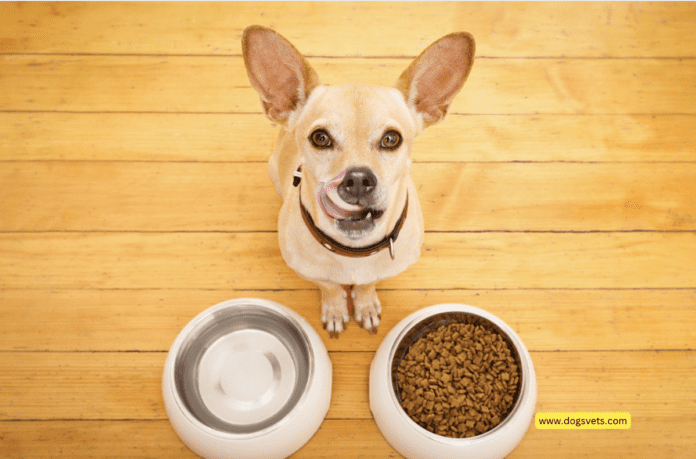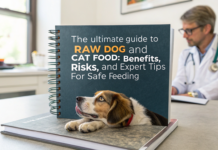Last Updated on November 8, 2023 by Dogs Vets
Top 10 Foods A Dog Should Never Eat + Important Tips to Know
Our beloved canine companions are often eager to share our meals, but not all human foods are safe for dogs to consume. In fact, some foods can be toxic and even fatal to our furry friends.
It’s essential for dog owners to be aware of these dangerous foods and take steps to prevent their dogs from ingesting them.
In this comprehensive guide, we’ll explore the top 10 foods that dogs should never eat, along with the reasons why these foods are harmful. We’ll also provide tips on how to keep your dog safe and healthy.
1. Chocolate
Chocolate is a popular and beloved household treat that can prove to be exceptionally dangerous for dogs. The toxic element within chocolate that poses a threat to canines is theobromine, a compound that can have severe effects on their health.
Even small amounts of chocolate can trigger a series of distressing symptoms in dogs, including vomiting, diarrhea, and heightened levels of hyperactivity.
The potential consequences of chocolate poisoning in dogs are deeply concerning. In severe cases, where larger quantities of chocolate are ingested, it can lead to more critical symptoms, such as seizures, tremors, and, in the most tragic instances, even death.
Recognizing the gravity of these effects underscores the importance of preventing any access to chocolate by dogs.
As responsible pet owners, it is vital to be diligent in safeguarding chocolate and chocolate-containing products, as dogs may be naturally inclined to seek out and consume them. Educating oneself and others about the dangers associated with chocolate is essential.
In case of accidental ingestion or the onset of related symptoms, immediate veterinary care is imperative to address the situation and provide the necessary treatment to secure the well-being of your cherished canine companions.
Understanding the risks linked to chocolate and theobromine toxicity and taking proactive steps to shield your dogs from potential exposure are fundamental aspects of responsible pet ownership.
By doing so, you can help ensure the longevity and health of your beloved four-legged family members.
2. Onions and Garlic
Onions and garlic, while flavorful and commonly used in human cuisine, are known to contain a compound called thiosulfate, which can have devastating effects on dogs.
Thiosulfate can damage a dog’s red blood cells and lead to a condition known as hemolytic anemia, which is characterized by a significant reduction in the number of healthy red blood cells. This can result in a range of detrimental health issues for our canine companions.
Even small amounts of onions or garlic can set off a series of concerning symptoms in dogs, including vomiting, diarrhea, and a noticeable weakness. These early signs serve as important indicators of potential toxicity.
In more severe cases, when the ingestion is more significant or chronic, anemia can become a life-threatening condition for dogs. The effects of anemia can include lethargy, pale gums, and, in extreme instances, fatality.
Responsible pet ownership involves being vigilant and preventing any access to onions and garlic, whether they are used as seasonings, ingredients in cooked dishes, or as part of processed foods.
By educating oneself and others about the dangers posed by these ingredients, you can take proactive measures to protect your canine companions.
In the event of accidental ingestion or the development of related symptoms, immediate veterinary care is crucial to address the situation and provide the necessary treatment to safeguard your dogs’ well-being.
Understanding the risks associated with onions and garlic and taking swift action to protect your pets from exposure to these ingredients are vital components of responsible pet ownership, ensuring the health and longevity of your beloved four-legged family members.
3. Grapes and Raisins
Grapes and raisins belong to a group of foods that are known to be highly toxic to dogs. The precise cause of this toxicity remains unknown, but it’s well-established that even a small amount of grapes or raisins can lead to severe kidney issues in our canine friends.
The potential dangers associated with grape and raisin consumption in dogs are a cause for serious concern. Ingesting these seemingly harmless fruits can trigger a range of adverse health effects. These effects may include vomiting, diarrhea, lethargy, and abdominal pain.
Of particular concern is the risk of kidney failure, which can result from grape or raisin toxicity in dogs. This life-threatening condition underscores the importance of preventing any access to grapes and raisins, whether fresh or in processed forms, such as those found in baked goods or trail mix.
As responsible pet owners, it is crucial to be proactive in keeping these hazardous fruits out of reach and educating oneself and others about the potential dangers they pose to dogs.
In the event of accidental ingestion, immediate veterinary attention is essential to address the situation and provide the necessary care to safeguard your canine companions’ well-being.
Understanding the risks associated with grapes and raisin toxicity and taking swift action to protect your dogs from exposure to these fruits are fundamental aspects of responsible pet ownership. By doing so, you can help ensure the longevity and health of your beloved four-legged family members.
4. Alcohol
Alcohol, classified as a depressant, can have a profound and harmful impact on dogs by inducing central nervous system depression. Even the ingestion of small amounts of alcohol can lead to a range of adverse effects in our canine companions. These effects may include vomiting, diarrhea, and noticeable incoordination.
It’s vital for pet owners to be aware of the risks associated with alcohol consumption by dogs and to exercise extreme caution in ensuring that their pets are not exposed to alcoholic substances. Dogs can be inadvertently attracted to the smell or taste of alcoholic beverages or products, making prevention a top priority.
In more severe cases, alcohol poisoning can occur in dogs, with symptoms escalating to seizures, coma, and in the most tragic instances, death. These severe consequences highlight the significance of avoiding any potential exposure to alcohol and reacting promptly when needed.
Responsible pet ownership involves understanding the dangers associated with alcohol and making a concerted effort to protect dogs from its harmful effects.
In the event of alcohol ingestion or the onset of related symptoms, immediate veterinary care is imperative to minimize risks and ensure the health and safety of your beloved furry companions.
5. Avocados
Avocados contain a naturally occurring substance known as persin, which serves as a fungicidal toxin. While avocados are a popular choice for many human dishes, it’s essential for pet owners to be aware of the potential dangers these fruits can pose to dogs.
Ingesting persin from avocados can lead to a variety of adverse health effects in our canine companions.
Common symptoms of avocado or persin toxicity in dogs include vomiting, diarrhea, and even difficulty breathing. These symptoms can be distressing for both the dog and the pet owner, underscoring the importance of preventing avocado consumption by dogs.
To ensure the safety and well-being of your furry friends, responsible pet owners should take measures to keep avocados and avocado-based products out of their reach.
While the risk of toxicity may vary depending on the size of the dog and the amount ingested, it’s best to err on the side of caution and avoid feeding avocados to dogs altogether. In cases where you suspect avocado ingestion or observe any unusual symptoms, immediate veterinary attention is crucial to address potential health risks and provide the necessary care.
Understanding the potential hazards associated with avocados and persin toxicity and being proactive in protecting your dogs from such risks is a key aspect of responsible pet ownership. By doing so, you can help ensure a long and healthy life for your beloved canine companions.
6. Raw Dough
Raw dough, whether it’s bread dough or pizza dough, can pose a significant and unexpected danger to dogs. The yeast present in the dough can ferment within the dog’s stomach, leading to the production of alcohol.
This alcohol production within the digestive system can result in a condition known as alcohol poisoning, which can have serious consequences for our canine companions.
The symptoms of alcohol poisoning in dogs can be alarming and distressing. They may include vomiting, diarrhea, incoordination, and in severe cases, even seizures. Recognizing these signs and understanding the potential risks associated with the ingestion of raw dough is crucial for responsible pet ownership.
To safeguard your dogs from the dangers of raw dough and yeast fermentation, it’s essential to be vigilant and prevent access to such dough products.
Even small amounts can result in alcohol poisoning, and dogs may be drawn to the smell and taste of these unbaked items.
In the event that you suspect your dog has consumed raw dough or exhibits any of the mentioned symptoms, prompt veterinary attention is of utmost importance. Timely intervention can help mitigate the risks and provide the necessary care to ensure the well-being of your furry friends.
Being aware of the potential hazards of raw dough, taking proactive measures to prevent ingestion, and seeking immediate veterinary assistance when necessary are vital aspects of responsible pet ownership.
By doing so, you can help protect your dogs from harm and ensure their long-term health and happiness.
7. Macadamia Nuts
“Macadamia nuts, though delightful to humans, can prove to be highly toxic to dogs. When ingested, these nuts can set off a range of distressing symptoms in our canine companions.
Common signs of macadamia nut toxicity in dogs include vomiting, diarrhea, tremors, and a dangerous increase in body temperature, known as hyperthermia.
It is crucial for pet owners to be aware of the potential harm posed by macadamia nuts and exercise caution in keeping these nuts and products containing them out of the reach of their four-legged friends. Even small quantities of macadamia nuts can have adverse effects on dogs, and thus, responsible pet ownership includes ensuring these nuts are not accessible to your pets.
Should you suspect that your dog has ingested macadamia nuts or displays any of the associated symptoms, immediate veterinary attention is vital.
Recognizing the risks and being proactive in safeguarding your canine companions from macadamia nut toxicity is a fundamental aspect of pet care, ensuring their health and well-being for years to come.”
8. Caffeine
“Caffeine, a potent stimulant found in various common products such as coffee, tea, and energy drinks, can have detrimental effects on dogs when ingested.
Even small amounts of caffeine can trigger a range of adverse reactions in our canine companions, including hyperactivity, restlessness, and vomiting. However, it’s essential to recognize that the consequences of caffeine poisoning can be far more severe.
In severe cases, where dogs consume significant quantities of caffeine, it can lead to alarming symptoms such as seizures, tremors, and, tragically, even death.
As responsible pet owners, it’s crucial to be vigilant and keep caffeine-containing products out of the reach of our furry friends. Dogs are naturally curious and may inadvertently consume substances harmful to them. Thus, pet-proofing your environment and being aware of the potential dangers posed by caffeine is paramount.
In the event of accidental ingestion, immediate veterinary assistance is imperative to mitigate the risks and ensure the well-being of your beloved pets.
Understanding the harmful effects of caffeine on dogs and taking proactive measures to prevent their exposure to it is a fundamental aspect of responsible pet ownership. By doing so, you can protect your four-legged family members from unnecessary harm and enjoy their companionship for years to come.”
9. Xylitol
Xylitol, a sugar alcohol commonly utilized as a sweetening agent in various products like chewing gum, candy, and a range of food items, poses a grave threat to dogs due to its toxicity. When dogs ingest xylitol, it triggers a swift and alarming decline in their blood sugar levels, a condition known as hypoglycemia.
This abrupt drop in blood sugar can give rise to a cascade of severe health issues in our canine companions, including vomiting, diarrhea, seizures, and, in the most tragic cases, even death.
Pet owners should be acutely aware of the hidden dangers that xylitol-laden products can pose to their dogs. It is crucial to exercise caution and vigilance, ensuring that these items are kept out of reach and inaccessible to pets.
Any accidental ingestion of xylitol-containing products should be treated as an emergency, and immediate veterinary attention is imperative. Understanding the risks associated with xylitol and being proactive in safeguarding your furry friends from exposure to it is paramount to ensuring their well-being and longevity.”
10. Bones
Cooked bones pose a significant hazard to dogs, as they have the potential to splinter, leading to serious health risks. When dogs ingest these splintered bones, it can result in choking or blockages in their digestive system.
Furthermore, the sharp fragments of cooked bones can puncture the stomach or intestines, causing severe internal injuries that may require surgical intervention.
It is crucial for dog owners to be aware of the dangers associated with feeding their pets cooked bones. Even though dogs may be drawn to the aroma and taste of these bones, the risks far outweigh any perceived benefits.
As responsible pet owners, it is essential to prioritize the safety and well-being of our canine companions by avoiding the temptation to give them cooked bones. Instead, opt for safe and suitable dog treats and toys that are specially designed to provide both entertainment and nutritional value without endangering their health.”
Tips to Keep Your Dog Safe
Here are some tips to help keep your dog safe from dangerous foods:
- Keep all potentially dangerous foods out of reach of your dog.
- Supervise your dog when they are around food.
- Be aware of the signs of food poisoning, such as vomiting, diarrhea, lethargy, and weakness.
- If you think your dog has eaten something poisonous, contact your veterinarian immediately.
- Teach your dog the “drop it” command.
- If you think your dog has eaten something poisonous, contact your veterinarian immediately.
Finally
It is important to be aware of the foods that are toxic to dogs and to take steps to prevent your dog from ingesting them. By following these tips, you can help keep your dog safe and healthy.
Additional Foods to Avoid
In addition to the top 10 foods listed above, there are a number of other foods that dog owners should avoid giving their pets. These include:
- Alcohol
- Alcohol-free beer
- Apple seeds
- Apricot pits
- Artificial sweeteners
- Candy
- Caffeine
- Cherries
- Citrus fruits
- Coconut
- Coffee
- Corn cobs
- Dairy products
- Eggplant
- Fatty foods
- Garlic
- Grapes
- Hops
- Ice cream
- Liver
- Macadamia nuts
- Milk
- Moldy foods
- Mushrooms
- Nuts
- Onions
- Peaches
- Pears
- Plums
- Potatoes
- Raisins
- Rhubarb
- Salt
- Tea
- Tomatoes
- Walnuts
- Xylitol
If You Think Your Dog Has Ingested Something Toxic
If you think your dog has ingested something toxic, it’s important to contact your veterinarian immediately. They will be able to assess the situation and provide the necessary treatment.
FAQs
1. What should I do if I think my dog has eaten something poisonous?
If you think your dog has eaten something poisonous, contact your veterinarian immediately. They will be able to advise you on the best course of action.
2. What are the signs of food poisoning in dogs?
The signs of food poisoning in dogs can vary depending on the type of food that was ingested. However, some common signs include vomiting, diarrhea, lethargy, weakness, and loss of appetite.
3. How can I prevent my dog from eating dangerous foods?
The best way to prevent your dog from eating dangerous foods is to keep them out of reach. This means storing all potentially dangerous foods in a sealed container or cupboard. You should also supervise your dog when they are around food and be aware of the signs of food poisoning.
4. What are some safe foods that I can give my dog?
There are many safe foods that you can give your dog, such as lean meats, cooked vegetables, and fruits. You can also find a variety of commercial dog foods that are formulated to meet your dog’s nutritional needs.
Signs and symptoms
1. Chocolate
Signs and symptoms of chocolate poisoning in dogs:
- Vomiting
- Diarrhea
- Hyperactivity
- Restlessness
- Increased thirst
- Increased urination
- Muscle tremors
- Seizures
- Coma
- Death
2. Onions and Garlic
Onions and garlic contain compounds that can damage a dog’s red blood cells, leading to anemia. Even small amounts of onions or garlic can be harmful to dogs.
Signs and symptoms of onion and garlic poisoning in dogs:
- Weakness
- Lethargy
- Pale gums
- Rapid breathing
- Decreased appetite
- Dark urine
- Collapse
- Death
3. Grapes and Raisins
Grapes and raisins can cause kidney failure in dogs. Even a small amount of grapes or raisins can be toxic.
Signs and symptoms of grape and raisin poisoning in dogs:
- Vomiting
- Diarrhea
- Lethargy
- Decreased urination
- Dark urine
- Painful urination
- Abdominal pain
- Collapse
- Death
4. Avocado
Avocados contain persin, a toxin that can cause vomiting, diarrhea, and difficulty breathing in dogs. Avocado pits can also be a choking hazard.
Signs and symptoms of avocado poisoning in dogs:
- Vomiting
- Diarrhea
- Abdominal pain
- Difficulty breathing
- Lethargy
- Weakness
- Collapse
5. Raw Dough
Raw dough contains yeast, which can ferment in a dog’s stomach and produce alcohol. Alcohol poisoning can cause vomiting, diarrhea, incoordination, seizures, and even death.
Signs and symptoms of alcohol poisoning in dogs:
- Vomiting
- Diarrhea
- Incoordination
- Drowsiness
- Lethargy
- Weakness
- Seizures
- Coma
- Death
6. Macadamia Nuts
Macadamia nuts are toxic to dogs, causing vomiting, diarrhea, tremors, and hyperthermia.
Signs and symptoms of macadamia nut poisoning in dogs:
- Vomiting
- Diarrhea
- Tremors
- Hyperthermia
- Weakness
- Lethargy
- Collapse
7. Caffeine
Caffeine is a stimulant that can cause hyperactivity, restlessness, and vomiting in dogs. In severe cases, caffeine poisoning can lead to seizures, tremors, and even death.
Signs and symptoms of caffeine poisoning in dogs:
- Hyperactivity
- Restlessness
- Vomiting
- Diarrhea
- Muscle tremors
- Seizures
- Coma
- Death
8. Xylitol
Xylitol is a sugar substitute that is often used in chewing gum, candy, and other foods. Xylitol is highly toxic to dogs, causing a rapid drop in blood sugar levels.
Signs and symptoms of xylitol poisoning in dogs:
- Vomiting
- Diarrhea
- Lethargy
- Weakness
- Seizures
- Coma
- Death
9. Bones
Cooked bones can splinter and cause choking or internal injuries in dogs. Raw bones can also harbor bacteria that can cause illness.
Signs and symptoms of bone poisoning in dogs:
- Choking
- Internal bleeding
- Vomiting
- Diarrhea
- Abdominal pain
- Lethargy
- Weakness
- Collapse
10. Fatty Foods
Fatty foods can cause pancreatitis in dogs. Pancreatitis is a serious inflammation of the pancreas that can be life-threatening.
Signs and symptoms of pancreatitis in dogs:
- Vomiting
- Diarrhea
- Abdominal pain
- Lethargy
- Weakness
- Fever
- Rapid breathing
Prevention
The best way to prevent your dog from ingesting toxic foods is to keep them out of reach. This means storing all potentially dangerous foods in a sealed container or cupboard. You should also supervise your dog when they are around food and be aware of the signs and symptoms of food poisoning.
Conclusion
By being aware of the top 10 foods that dogs should never eat, dog owners can help keep their furry friends safe and healthy. By following the tips above, you can prevent your dog from ingesting something that could make them sick.
Facts Check
We strive to provide the latest valuable information for pet lovers with accuracy and fairness. If you would like to add to this post or advertise with us, don’t hesitate to reach us. If you see something that doesn’t look right, contact us!

















